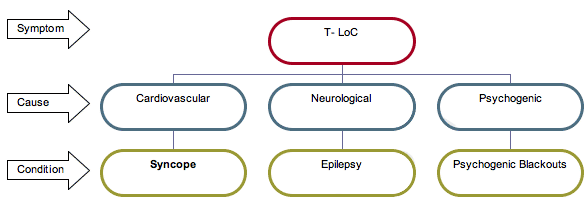Blackout/Transient Loss of Consciousness (T- LoC) and Syncope Epidemiology
Blackouts/T- LoCs
Blackouts/T-LoCs commonly result from three main types of cause: cardiovascular, neurological or psychogenic.1 Each of these causes is associated to a specific medical condition.

What is Syncope?
Syncope is technically defined as a transient, self-limited loss of consciousness, usually leading to collapse.1
- The underlying cause of syncope is a temporary but sudden reduction in blood supply, and hence oxygen, to the brain as a result of cardiovascular conditions1
- The temporary but sudden reduction in blood supply triggering syncope is caused by vasodilation, hypotension and arrhythmia (bradycardia, tachycardia or valvular disease)1
- The onset of syncope is relatively rapid, and recovery from loss of consciousness is spontaneous, complete and usually prompt1
- Reflex syncope is known as vasovagal syncope in adults and reflex anoxic seizures/reflex asystolic syncope in children
The Prevalence of Syncope
-
Most T-LoC cases presented to primary care or emergency departments are in fact syncope2

- Syncope is a very common, yet little known condition: up to 50 percent of people experience syncope at least once during their lives3
- Approximately 35 percent of patients have recurrent syncope episodes within three years and of these 82 percent experience at least one additional episode within two years1
- In a UK study of almost 300 children diagnosed with RAS, 72% of these children were initially wrongly diagnosed with breath holding, temper tantrums, epilepsy or allergies4
Risk of Syncope
According to the European Society of Cardiology Guidelines, identifying the cardiac causes of syncope is of critical importance, as many arrhythmias and other types of cardiac disease are now treatable with drugs and other devices.1
- Some T-LoC can be a first symptom of fatal arrhythmia, which causes over 100,000 deaths every year in the UK3
- Sudden cardiac death is often attributed to cardiac arrhythmia and is today recognised as the most common killer in the US, accounting for around 350,000 deaths annually. Overall, event rates in Europe are similar to those in the United States, with significant geographic variations reported5
- Most sudden deaths in people under 30-years-old are caused by inherited cardiomyopathies and arrhythmias3
- Recurrent syncope impacts patients’ quality of life to the same degree as other chronic diseases such as rheumatoid arthritis1
- Syncope may result in injuries to the patients or to others as a result of accidents, leading to e.g. fractures1
What is Epilepsy?
Epilepsy is a neurological condition, characterised by recurrent, unprovoked seizure. A ‘seizure’ can be defined as a ‘manifestation of an abnormal and excessive synchronized discharge of a set of cerebral neurones.’6
The Prevalence of Epilepsy
Epilepsy has a prevalence in the UK of between 0.7-1%7 and affects around 50 million people worldwide.8 To put this into context, despite the fact that epilepsy is one of the most common serious neurological conditions in the UK, there are only 1-2 new cases per year within the average list size of a UK general practitioner.9
Risk of Epilepsy
Medical complications include:
- Status epilepticus
- Injuries from falls
- Aspiration of fluid/food particles into the lungs
- Sudden unexpected death
There are also social burdens, including:
- Mistreatment
- Social stigma
- Educational difficulties
- Driving limitations
- Restrictions concerning employment
Patients who are incorrectly diagnosed with epilepsy unnecessarily bear these social burdens, which can seriously affect quality of life. They may also be living with the potentially fatal risks of undiagnosed syncope.6
References
- European Society of Cardiology, Guidelines on Management (Diagnosis and Treatment) of Syncope, Update 2004 http://www.escardio.org/
- Fitzpatrick, A; Cooper P. Diagnosis and Management of Patients with Blackouts. Heart 2006; 92: 559-568
- Department of Health National Service Framework. Coronary heart disease. Chapter 8. Arrhythmias and sudden cardiac death. https://www.gov.uk/government/publications/quality-standards-for-coronar… on 24 July 2013
- Lobban T, Mordekar S, Collier J et al. Syncopal seizure semiology in children.
- AAC/AHA/ESC Pocket Guideline, Management of Patients with Ventricular Arrhythmias and the Prevention of Sudden Cardiac Death http://my.americanheart.org/idc/groups/ahaecc-internal/@wcm/@sop/documen…
- Ali I, Lobban T, Sutton R, Everitt A, Francis D P. Emergence of the Rapid Access Blackout Clinic (unpublished)
- Stokes T, Shaw E J, Juarez-Garcia A et al. (2004). Clinical guidelines and evidence review for the epilepsies: diagnosis and management in adults and children in primary and secondary care. London: Royal College of General Practitioners
- World Health Organization - Epilepsy. http://www.who.int/mental_health/neurology/epilepsy/en/index.html
- MacDonald B K, Cockerell O C, Sander J W A S, Shorvon S D (2000). The incidence and lifetime prevalence of neurological disorders in a prospective community-based study in the UK. Brain 123; (Number 4), April 2000, 665-676(12)